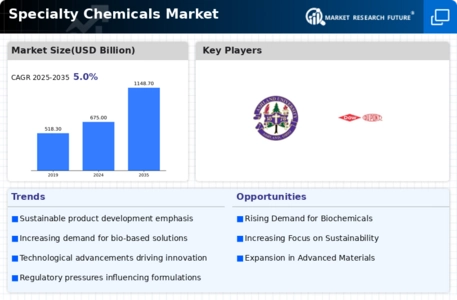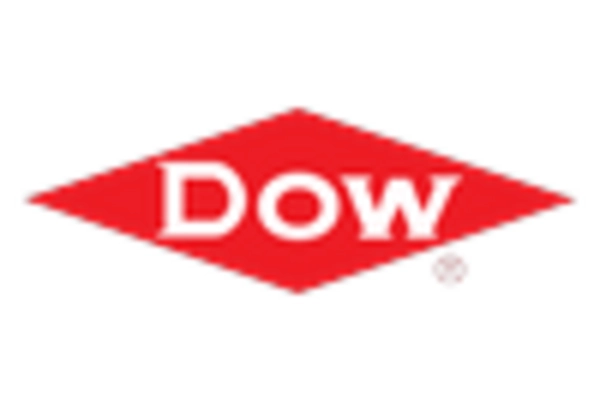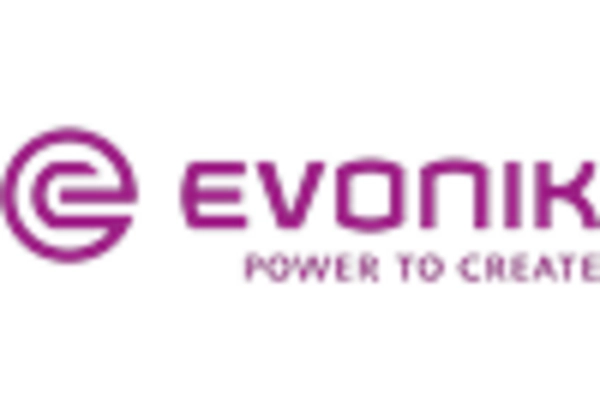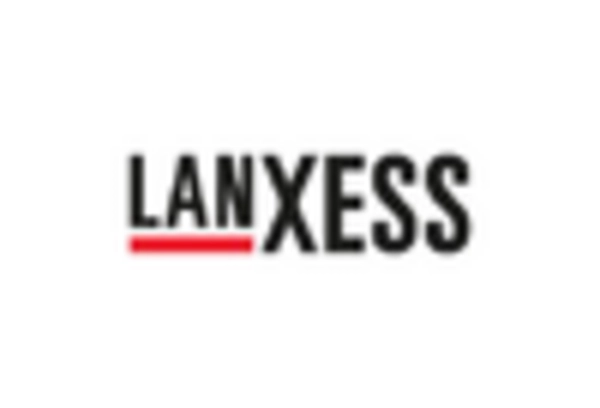-
Executive Summary
-
Market Introduction
-
Definition 20
-
Scope of the Study 20
-
List of Assumptions 21
-
Market Structure
-
21
-
Research Methodology
-
Research Process 23
-
Primary
-
Research 24
-
Secondary Research 25
-
Market Size Estimation 25
-
Forecast Model 26
-
Market Dynamics
-
Introduction 28
-
Drivers 29
- Diverse application range of specialty chemicals 29
- Shift from commodity chemicals to specialty chemicals 30
- Favorable
-
trend in the automotive industry 31
-
Restraints 32
- Fluctuation
-
in raw material prices 32
-
Opportunities 32
- Market collaborations
- Shifting industrial
-
in the cosmetic industry along with increasing demand 32
-
dynamics to Asia Pacific and Middle East 33
-
Challenges 33
- Stringent
- Prices associated with biobased products 34
-
regulatory policies 33
-
Market Factor Analysis
-
Supply Chain Analysis 36
- Raw
- Specialty chemical Producers 37
- Distribution
- Application Industry 37
-
Material Suppliers 36
-
Channel 37
-
Porter’s Five Force
- Threat of New Entrants 38
- Threat of Rivalry 38
- Threat of Substitute 38
- Bargaining Power of Supplier 39
-
Analysis 38
-
5.2.5
-
Bargaining Power of Buyer 39
-
Global Specialty Chemicals Market, By
-
Source
-
Introduction 41
-
Crude Oil 43
-
Naphtha 44
-
6.4
-
Ethane 45
-
Propane 46
-
Wood 47
-
Butane 48
-
Others
-
49
-
Global Specialty Chemicals Market, By Type
-
Introduction
-
51
-
Agrochemicals 54
- Insecticide 55
- Fungicides 56
- Herbicides 57
- Ammonium Sulphate Fertilizers 58
- Calcium
- Others 60
-
Nitrate Fertilizers 59
-
Flavors Ingredients 61
- Beverages 63
- Savory 64
- Others 65
- Hair Care 67
- Personal Care 68
- Fabric Care 69
- Others 70
-
7.3.1
-
Dairy 62
-
7.4
-
Fragrances Ingredients 66
-
Dyes & Pigments 71
-
7.6
-
Personal Care Active Ingredients 72
-
Water Treatment Chemicals 73
- Other Water Treatment Chemicals 75
-
7.7.1
-
Calcium Nitrate 74
-
Construction
- Calcium Carbonate 77
- Other Construction Chemicals
-
Chemicals 76
-
78
-
Surfactants 79
- Anionic 80
- Nonionic 81
- Amphoteric 83
-
7.9.3
-
Cationic 82
-
Textile Chemicals 84
-
Polymer
-
Additives 85
-
Bio-Based Chemicals 86
- Acetic Acid 87
- Ethanol 89
- Others 90
-
7.12.2
-
Furfural 88
-
Others 91
-
Global Specialty Chemicals Market, By Region
-
Introduction 93
-
North America 97
- U.S 101
- Canada 103
-
Europe
- Germany 111
- UK 114
- France 116
- Italy
- Poland 122
- Rest of Europe 126
-
107
-
120
-
Asia-Pacific 128
- China 132
- Japan 135
- India 139
- Australia
- South Korea 144
- Rest of Asia-Pacific
-
& New Zealand 141
-
148
-
Middle East & Africa 150
- Turkey 154
- Iran
- Rest of Middle East & Africa 160
-
157
-
Latin America 163
- Brazil 168
- Mexico 170
- Argentina 174
- Rest
-
of Latin America 177
-
Competitive Landscape
-
Introduction 181
-
Key development analysis 181
-
Expansion 182
- Acquisition
- Agreement 185
- Product Launch 186
-
184
-
Company
-
Profile
-
Solvay SA 188
- Company Overview 188
- Financial
- Products Offerings 189
- Key Developments 189
- SWOT Analysis 190
- Key Strategy 190
-
Overview 188
-
AkzoNobel NV 191
- Company Overview 191
- Financial Overview 191
- Products
- Key Developments 192
- SWOT Analysis 193
- Key Strategy 193
-
Offerings 192
-
Lenzing AG 194
- Company Overview
- Financial Overview 194
- Products Offerings 195
- SWOT Analysis 195
- Key Strategy 195
-
194
-
10.3.4
-
Key Developments 195
-
BHS Specialty Chemicals 196
- Company Overview 196
- Products Offerings 196
- Key Developments
- SWOT Analysis 197
- Key Strategy 197
-
10.4.2
-
Financial Overview 196
-
197
-
Givaudan
- Company Overview 198
- Financial Overview 198
- Key Developments 199
- SWOT Analysis
- Key Strategy 200
-
198
-
10.5.3
-
Products Offerings 199
-
200
-
Ashland Inc 201
- Company Overview
- Financial Overview 201
- Products Offerings 202
- SWOT Analysis 203
- Key Strategy 203
-
201
-
10.6.4
-
Key Developments 202
-
Evonik Industries AG 204
- Company Overview 204
- Financial
- Products Offerings 205
- Key Developments Efficiency
- SWOT Analysis 206
- Key Strategy 206
-
Overview 204
-
205
-
Henkel
- Company Overview 207
- Financial Overview
- Products Offerings 208
- Key Developments 208
- Key Strategy 209
-
AG & Co. KGaA 207
-
207
-
10.8.5
-
SWOT Analysis 209
-
ExxonMobil Corporation
- Company Overview 210
- Financial Overview 210
- Key Developments 211
- SWOT Analysis
- Key Strategy 212
-
210
-
10.9.3
-
Products Offerings 211
-
212
-
DowDuPont, Inc 213
- Company
- Financial Overview 213
- Products Offerings
- Key Developments 214
- SWOT Analysis 215
-
Overview 213
-
214
-
10.10.6
-
Key Strategy 215
-
BASF SE 216
- Company Overview 216
- Products Offerings 217
- Key Developments
- SWOT Analysis 218
- Key Strategy 218
-
10.11.2
-
Financial Overview 216
-
217
-
Lanxess
- Company Overview 219
- Financial Overview 219
- Products Offerings 220
- Key Developments 220
- Key Strategy 221
-
AG 219
-
10.12.5
-
SWOT Analysis 221
-
Clariant AG 222
- Financial Overview 222
- Products Offerings
- Key Developments 224
- SWOT Analysis 224
-
10.13.1
-
Company Overview 222
-
223
-
10.13.6
-
Key Strategy 224
-
Croda International Inc. 225
- Company Overview
- Financial Overview 225
- Products Offerings 226
- SWOT Analysis 227
- Key Strategy 227
-
225
-
10.14.4
-
Key Developments 226
-
H.B. Fuller 228
- Company Overview 228
- Financial
- Products Offerings 229
- Key Developments 229
- SWOT Analysis 230
- Key Strategy 230
-
Overview 228
-
Conclusion
-
List of Tables
-
LIST OF ASSUMPTIONS 21
-
GLOBAL
-
SPECIALTY CHEMICALS MARKET, BY SOURCE, 2023-2030 (USD MILLION) 41
-
GLOBAL
-
SPECIALTY CHEMICALS MARKET, BY SOURCE, 2023-2030 (KT) 42
-
GLOBAL SPECIALTY
-
CHEMICALS MARKET FOR CRUDE OIL, 2023-2030 (USD MILLION) 43
-
GLOBAL SPECIALTY
-
CHEMICALS MARKET FOR CRUDE OIL, 2023-2030 (KT) 43
-
GLOBAL SPECIALTY
-
CHEMICALS MARKET FOR NAPHTHA, 2023-2030 (USD MILLION) 44
-
GLOBAL SPECIALTY
-
CHEMICALS MARKET FOR NAPHTHA, 2023-2030 (KT) 44
-
GLOBAL SPECIALTY CHEMICALS
-
MARKET FOR ETHANE, 2023-2030 (USD MILLION) 45
-
GLOBAL SPECIALTY CHEMICALS
-
MARKET FOR ETHANE, 2023-2030 (KT) 45
-
GLOBAL SPECIALTY CHEMICALS MARKET
-
FOR PROPANE, 2023-2030 (USD MILLION) 46
-
GLOBAL SPECIALTY CHEMICALS
-
MARKET FOR PROPANE, 2023-2030 (KT) 46
-
GLOBAL SPECIALTY CHEMICALS MARKET
-
FOR WOOD, 2023-2030 (USD MILLION) 47
-
GLOBAL SPECIALTY CHEMICALS MARKET
-
FOR WOOD, 2023-2030 (KT) 47
-
GLOBAL SPECIALTY CHEMICALS MARKET FOR
-
BUTANE, 2023-2030 (USD MILLION) 48
-
GLOBAL SPECIALTY CHEMICALS MARKET
-
FOR BUTANE, 2023-2030 (KT) 48
-
GLOBAL SPECIALTY CHEMICALS MARKET FOR
-
OTHERS, 2023-2030 (USD MILLION) 49
-
GLOBAL SPECIALTY CHEMICALS MARKET
-
FOR OTHERS, 2023-2030 (KT) 49
-
GLOBAL SPECIALTY CHEMICALS MARKET, BY
-
TYPE, 2023-2030 (USD MILLION) 52
-
GLOBAL SPECIALTY CHEMICALS MARKET,
-
BY TYPE, 2023-2030 (KT) 53
-
GLOBAL SPECIALTY CHEMICALS MARKET FOR AGROCHEMICALS,
-
GLOBAL SPECIALTY CHEMICALS MARKET FOR AGROCHEMICALS,
-
GLOBAL SPECIALTY CHEMICALS MARKET FOR INSECTICIDE,
-
GLOBAL SPECIALTY CHEMICALS MARKET FOR INSECTICIDE,
-
GLOBAL SPECIALTY CHEMICALS MARKET FOR FUNGICIDES,
-
GLOBAL SPECIALTY CHEMICALS MARKET FOR FUNGICIDES,
-
GLOBAL SPECIALTY CHEMICALS MARKET FOR HERBICIDES,
-
GLOBAL SPECIALTY CHEMICALS MARKET FOR HERBICIDES,
-
GLOBAL SPECIALTY CHEMICALS MARKET FOR AMMONIUM SULPHATE
-
FERTILIZERS, 2023-2030 (USD MILLION) 58
-
GLOBAL SPECIALTY CHEMICALS
-
MARKET FOR AMMONIUM SULPHATE FERTILIZERS, 2023-2030 (KT) 58
-
GLOBAL
-
SPECIALTY CHEMICALS MARKET FOR CALCIUM NITRATE FERTILIZERS, 2023-2030 (USD MILLION)
-
59
-
GLOBAL SPECIALTY CHEMICALS MARKET FOR CALCIUM NITRATE FERTILIZERS,
-
GLOBAL SPECIALTY CHEMICALS MARKET FOR OTHERS, 2023-2030
-
(USD MILLION) 60
-
GLOBAL SPECIALTY CHEMICALS MARKET FOR OTHERS, 2023-2030
-
(KT) 60
-
GLOBAL SPECIALTY CHEMICALS MARKET FOR FLAVOURS INGREDIENTS,
-
GLOBAL SPECIALTY CHEMICALS MARKET FOR FLAVOURS
-
INGREDIENTS, 2023-2030 (KT) 61
-
GLOBAL SPECIALTY CHEMICALS MARKET FOR
-
DAIRY, 2023-2030 (USD MILLION) 62
-
GLOBAL SPECIALTY CHEMICALS MARKET
-
FOR DAIRY, 2023-2030 (KT) 62
-
GLOBAL SPECIALTY CHEMICALS MARKET FOR
-
BEVERAGES, 2023-2030 (USD MILLION) 63
-
GLOBAL SPECIALTY CHEMICALS MARKET
-
FOR BEVERAGES, 2023-2030 (KT) 63
-
GLOBAL SPECIALTY CHEMICALS MARKET
-
FOR SAVORY, 2023-2030 (USD MILLION) 64
-
GLOBAL SPECIALTY CHEMICALS
-
MARKET FOR SAVORY, 2023-2030 (KT) 64
-
GLOBAL SPECIALTY CHEMICALS MARKET
-
FOR OTHERS, 2023-2030 (USD MILLION) 65
-
GLOBAL SPECIALTY CHEMICALS
-
MARKET FOR OTHERS, 2023-2030 (KT) 65
-
GLOBAL SPECIALTY CHEMICALS MARKET
-
FOR FRAGRANCES INGREDIENTS, 2023-2030 (USD MILLION) 66
-
GLOBAL SPECIALTY
-
CHEMICALS MARKET FOR FRAGRANCES INGREDIENTS, 2023-2030 (KT) 66
-
GLOBAL
-
SPECIALTY CHEMICALS MARKET FOR HAIR CARE, 2023-2030 (USD MILLION) 67
-
TABLE
-
GLOBAL SPECIALTY CHEMICALS MARKET FOR HAIR CARE, 2023-2030 (KT) 67
-
TABLE
-
GLOBAL SPECIALTY CHEMICALS MARKET FOR PERSONAL CARE, 2023-2030 (USD MILLION)
-
68
-
GLOBAL SPECIALTY CHEMICALS MARKET FOR PERSONAL CARE, 2023-2030
-
(KT) 68
-
GLOBAL SPECIALTY CHEMICALS MARKET FOR FABRIC CARE, 2023-2030
-
(USD MILLION) 69
-
GLOBAL SPECIALTY CHEMICALS MARKET FOR FABRIC CARE,
-
GLOBAL SPECIALTY CHEMICALS MARKET FOR OTHERS, 2023-2030
-
(USD MILLION) 70
-
GLOBAL SPECIALTY CHEMICALS MARKET FOR OTHERS, 2023-2030
-
(KT) 70
-
GLOBAL SPECIALTY CHEMICALS MARKET FOR DYES & PIGMENTS,
-
GLOBAL SPECIALTY CHEMICALS MARKET FOR DYES
-
& PIGMENTS, 2023-2030 (KT) 71
-
GLOBAL SPECIALTY CHEMICALS MARKET
-
FOR PERSONAL CARE ACTIVE INGREDIENTS, 2023-2030 (USD MILLION) 72
-
GLOBAL
-
SPECIALTY CHEMICALS MARKET FOR PERSONAL CARE ACTIVE INGREDIENTS, 2023-2030 (KT)
-
72
-
GLOBAL SPECIALTY CHEMICALS MARKET FOR WATER TREATMENT CHEMICALS,
-
GLOBAL SPECIALTY CHEMICALS MARKET FOR WATER
-
TREATMENT CHEMICALS, 2023-2030 (KT) 73
-
GLOBAL SPECIALTY CHEMICALS
-
MARKET FOR CALCIUM NITRATE, 2023-2030 (USD MILLION) 74
-
GLOBAL SPECIALTY
-
CHEMICALS MARKET FOR CALCIUM NITRATE, 2023-2030 (KT) 74
-
GLOBAL SPECIALTY
-
CHEMICALS MARKET FOR OTHER WATER TREATMENT CHEMICALS, 2023-2030 (USD MILLION) 75
-
GLOBAL SPECIALTY CHEMICALS MARKET FOR OTHER WATER TREATMENT CHEMICALS,
-
GLOBAL SPECIALTY CHEMICALS MARKET FOR CONSTRUCTION
-
CHEMICALS, 2023-2030 (USD MILLION) 76
-
GLOBAL SPECIALTY CHEMICALS MARKET
-
FOR CONSTRUCTION CHEMICALS, 2023-2030 (KT) 76
-
GLOBAL SPECIALTY CHEMICALS
-
MARKET FOR CALCIUM CARBONATE, 2023-2030 (USD MILLION) 77
-
GLOBAL SPECIALTY
-
CHEMICALS MARKET FOR CALCIUM CARBONATE, 2023-2030 (KT) 77
-
GLOBAL SPECIALTY
-
CHEMICALS MARKET FOR OTHER CONSTRUCTION CHEMICALS, 2023-2030 (USD MILLION) 78
-
GLOBAL SPECIALTY CHEMICALS MARKET FOR OTHER CONSTRUCTION CHEMICALS, 2023-2030
-
(KT) 78
-
GLOBAL SPECIALTY CHEMICALS MARKET FOR SURFACTANTS, 2023-2030
-
(USD MILLION) 79
-
GLOBAL SPECIALTY CHEMICALS MARKET FOR SURFACTANTS,
-
GLOBAL SPECIALTY CHEMICALS MARKET FOR ANIONIC, 2023-2030
-
(USD MILLION) 80
-
GLOBAL SPECIALTY CHEMICALS MARKET FOR ANIONIC, 2023-2030
-
(KT) 80
-
GLOBAL SPECIALTY CHEMICALS MARKET FOR NONIONIC, 2023-2030
-
(USD MILLION) 81
-
GLOBAL SPECIALTY CHEMICALS MARKET FOR NONIONIC, 2023-2030
-
(KT) 81
-
GLOBAL SPECIALTY CHEMICALS MARKET FOR CATIONIC, 2023-2030
-
(USD MILLION) 82
-
GLOBAL SPECIALTY CHEMICALS MARKET FOR CATIONIC, 2023-2030
-
(KT) 82
-
GLOBAL SPECIALTY CHEMICALS MARKET FOR AMPHOTERIC, 2023-2030
-
(USD MILLION) 83
-
GLOBAL SPECIALTY CHEMICALS MARKET FOR AMPHOTERIC,
-
GLOBAL SPECIALTY CHEMICALS MARKET FOR TEXTILE CHEMICALS,
-
GLOBAL SPECIALTY CHEMICALS MARKET FOR TEXTILE
-
CHEMICALS, 2023-2030 (KT) 84
-
GLOBAL SPECIALTY CHEMICALS MARKET FOR
-
POLYMER ADDITIVES, 2023-2030 (USD MILLION) 85
-
GLOBAL SPECIALTY CHEMICALS
-
MARKET FOR POLYMER ADDITIVES, 2023-2030 (KT) 85
-
GLOBAL SPECIALTY CHEMICALS
-
MARKET FOR BIO-BASED CHEMICALS, 2023-2030 (USD MILLION) 86
-
GLOBAL
-
SPECIALTY CHEMICALS MARKET FOR BIO-BASED CHEMICALS, 2023-2030 (KT) 86
-
TABLE
-
GLOBAL SPECIALTY CHEMICALS MARKET FOR ACETIC ACID, 2023-2030 (USD MILLION) 87
-
GLOBAL SPECIALTY CHEMICALS MARKET FOR ACETIC ACID, 2023-2030 (KT) 87
-
GLOBAL SPECIALTY CHEMICALS MARKET FOR FURFURAL, 2023-2030 (USD MILLION)
-
88
-
GLOBAL SPECIALTY CHEMICALS MARKET FOR FURFURAL, 2023-2030 (KT)
-
88
-
GLOBAL SPECIALTY CHEMICALS MARKET FOR ETHANOL, 2023-2030 (USD MILLION)
-
89
-
GLOBAL SPECIALTY CHEMICALS MARKET FOR ETHANOL, 2023-2030 (KT) 89
-
GLOBAL SPECIALTY CHEMICALS MARKET FOR OTHERS, 2023-2030 (USD MILLION)
-
90
-
GLOBAL SPECIALTY CHEMICALS MARKET FOR OTHERS, 2023-2030 (KT) 90
-
GLOBAL SPECIALTY CHEMICALS MARKET FOR OTHERS, 2023-2030 (USD MILLION)
-
91
-
GLOBAL SPECIALTY CHEMICALS MARKET FOR OTHERS, 2023-2030 (KT) 91
-
GLOBAL SPECIALTY CHEMICALS MARKET, BY REGION, 2023-2030 (USD MILLION)
-
93
-
GLOBAL SPECIALTY CHEMICALS MARKET, BY REGION, 2023-2030 (KILOTONS)
-
94
-
GLOBAL SPECIALTY CHEMICALS MARKET, BY SOURCE, 2023-2030 (USD MILLION)
-
95
-
GLOBAL SPECIALTY CHEMICALS MARKET, BY SOURCE, 2023-2030 (KILOTONS)
-
95
-
GLOBAL SPECIALTY CHEMICALS MARKET, BY TYPE, 2023-2030 (USD MILLION)
-
96
-
GLOBAL SPECIALTY CHEMICALS MARKET, BY TYPE, 2023-2030 (KILOTONS)
-
97
-
NORTH AMERICA SPECIALTY CHEMICALS MARKET, BY COUNTRY, 2023-2030
-
(USD MILLION) 98
-
NORTH AMERICA SPECIALTY CHEMICALS MARKET, BY COUNTRY,
-
NORTH AMERICA SPECIALTY CHEMICALS MARKET,
-
BY SOURCE, 2023-2030 (USD MILLION) 98
-
NORTH AMERICA SPECIALTY CHEMICALS
-
MARKET, BY SOURCE, 2023-2030 (KILOTONS) 99
-
NORTH AMERICA SPECIALTY
-
CHEMICALS MARKET, BY TYPE, 2023-2030 (USD MILLION) 99
-
NORTH AMERICA
-
SPECIALTY CHEMICALS MARKET, BY TYPE, 2023-2030 (KILOTONS) 100
-
U.S
-
SPECIALTY CHEMICALS MARKET, BY SOURCE, 2023-2030 (USD MILLION) 101
-
TABLE 109
-
U.S SPECIALTY CHEMICALS MARKET, BY SOURCE, 2023-2030 (KILOTONS) 101
-
TABLE 110
-
U.S SPECIALTY CHEMICALS MARKET, BY TYPE, 2023-2030 (USD MILLION) 102
-
TABLE
-
U.S SPECIALTY CHEMICALS MARKET, BY TYPE, 2023-2030 (KILOTONS) 103
-
TABLE
-
CANADA SPECIALTY CHEMICALS MARKET, BY SOURCE, 2023-2030 (USD MILLION) 103
-
CANADA SPECIALTY CHEMICALS MARKET, BY SOURCE, 2023-2030 (KILOTONS) 104
-
CANADA SPECIALTY CHEMICALS MARKET, BY TYPE, 2023-2030 (USD MILLION)
-
105
-
CANADA SPECIALTY CHEMICALS MARKET, BY TYPE, 2023-2030 (KILOTONS)
-
106
-
EUROPE SPECIALTY CHEMICALS MARKET, BY COUNTRY, 2023-2030 (USD
-
MILLION) 107
-
EUROPE SPECIALTY CHEMICALS MARKET, BY COUNTRY, 2023-2030
-
(KILOTONS) 108
-
EUROPE SPECIALTY CHEMICALS MARKET, BY SOURCE, 2023-2030
-
(USD MILLION) 108
-
EUROPE SPECIALTY CHEMICALS MARKET, BY SOURCE, 2023-2030
-
(KILOTONS) 109
-
EUROPE SPECIALTY CHEMICALS MARKET, BY TYPE, 2023-2030
-
(USD MILLION) 109
-
EUROPE SPECIALTY CHEMICALS MARKET, BY TYPE, 2023-2030
-
(KILOTONS) 110
-
GERMANY SPECIALTY CHEMICALS MARKET, BY SOURCE, 2023-2030
-
(USD MILLION) 111
-
GERMANY SPECIALTY CHEMICALS MARKET, BY SOURCE,
-
GERMANY SPECIALTY CHEMICALS MARKET, BY TYPE,
-
GERMANY SPECIALTY CHEMICALS MARKET, BY
-
TYPE, 2023-2030 (KILOTONS) 113
-
UK SPECIALTY CHEMICALS MARKET, BY
-
SOURCE, 2023-2030 (USD MILLION) 114
-
UK SPECIALTY CHEMICALS MARKET,
-
BY SOURCE, 2023-2030 (KILOTONS) 114
-
UK SPECIALTY CHEMICALS MARKET,
-
BY TYPE, 2023-2030 (USD MILLION) 115
-
UK SPECIALTY CHEMICALS MARKET,
-
BY TYPE, 2023-2030 (KILOTONS) 116
-
FRANCE SPECIALTY CHEMICALS MARKET,
-
BY SOURCE, 2023-2030 (USD MILLION) 116
-
FRANCE SPECIALTY CHEMICALS
-
MARKET, BY SOURCE, 2023-2030 (KILOTONS) 117
-
FRANCE SPECIALTY CHEMICALS
-
MARKET, BY TYPE, 2023-2030 (USD MILLION) 118
-
FRANCE SPECIALTY CHEMICALS
-
MARKET, BY TYPE, 2023-2030 (KILOTONS) 119
-
ITALY SPECIALTY CHEMICALS
-
MARKET, BY SOURCE, 2023-2030 (USD MILLION) 120
-
ITALY SPECIALTY CHEMICALS
-
MARKET, BY SOURCE, 2023-2030 (KILOTONS) 120
-
ITALY SPECIALTY CHEMICALS
-
MARKET, BY TYPE, 2023-2030 (USD MILLION) 121
-
ITALY SPECIALTY CHEMICALS
-
MARKET, BY TYPE, 2023-2030 (KILOTONS) 122
-
POLAND SPECIALTY CHEMICALS
-
MARKET, BY SOURCE, 2023-2030 (USD MILLION) 122
-
POLAND SPECIALTY CHEMICALS
-
MARKET, BY SOURCE, 2023-2030 (KILOTONS) 123
-
POLAND SPECIALTY CHEMICALS
-
MARKET, BY TYPE, 2023-2030 (USD MILLION) 124
-
POLAND SPECIALTY CHEMICALS
-
MARKET, BY TYPE, 2023-2030 (KILOTONS) 125
-
REST OF EUROPE SPECIALTY
-
CHEMICALS MARKET, BY SOURCE, 2023-2030 (USD MILLION) 126
-
REST OF
-
EUROPE SPECIALTY CHEMICALS MARKET, BY SOURCE, 2023-2030 (KILOTONS) 126
-
TABLE
-
REST OF EUROPE SPECIALTY CHEMICALS MARKET, BY TYPE, 2023-2030 (USD MILLION)
-
127
-
REST OF EUROPE SPECIALTY CHEMICALS MARKET, BY TYPE, 2023-2030
-
(KILOTONS) 128
-
ASIA-PACIFIC SPECIALTY CHEMICALS MARKET, BY COUNTRY,
-
ASIA-PACIFIC SPECIALTY CHEMICALS MARKET,
-
BY COUNTRY, 2023-2030 (KILOTONS) 129
-
ASIA-PACIFIC SPECIALTY CHEMICALS
-
MARKET, BY SOURCE, 2023-2030 (USD MILLION) 130
-
ASIA-PACIFIC SPECIALTY
-
CHEMICALS MARKET, BY SOURCE, 2023-2030 (KILOTONS) 130
-
ASIA-PACIFIC
-
SPECIALTY CHEMICALS MARKET, BY TYPE, 2023-2030 (USD MILLION) 131
-
TABLE 151
-
ASIA-PACIFIC SPECIALTY CHEMICALS MARKET, BY TYPE, 2023-2030 (KILOTONS) 132
-
TABLE
-
CHINA SPECIALTY CHEMICALS MARKET, BY SOURCE, 2023-2030 (USD MILLION) 132
-
CHINA SPECIALTY CHEMICALS MARKET, BY SOURCE, 2023-2030 (KILOTONS) 133
-
CHINA SPECIALTY CHEMICALS MARKET, BY TYPE, 2023-2030 (USD MILLION) 134
-
CHINA SPECIALTY CHEMICALS MARKET, BY TYPE, 2023-2030 (KILOTONS) 135
-
JAPAN SPECIALTY CHEMICALS MARKET, BY SOURCE, 2023-2030 (USD MILLION)
-
135
-
JAPAN SPECIALTY CHEMICALS MARKET, BY SOURCE, 2023-2030 (KILOTONS)
-
136
-
JAPAN SPECIALTY CHEMICALS MARKET, BY TYPE, 2023-2030 (USD MILLION)
-
137
-
JAPAN SPECIALTY CHEMICALS MARKET, BY TYPE, 2023-2030 (KILOTONS)
-
138
-
INDIA SPECIALTY CHEMICALS MARKET, BY SOURCE, 2023-2030 (USD MILLION)
-
139
-
INDIA SPECIALTY CHEMICALS MARKET, BY SOURCE, 2023-2030 (KILOTONS)
-
139
-
INDIA SPECIALTY CHEMICALS MARKET, BY TYPE, 2023-2030 (USD MILLION)
-
140
-
INDIA SPECIALTY CHEMICALS MARKET, BY TYPE, 2023-2030 (KILOTONS)
-
141
-
AUSTRALIA & NEW ZEALAND SPECIALTY CHEMICALS MARKET, BY SOURCE,
-
AUSTRALIA & NEW ZEALAND SPECIALTY
-
CHEMICALS MARKET, BY SOURCE, 2023-2030 (KILOTONS) 142
-
AUSTRALIA &
-
NEW ZEALAND SPECIALTY CHEMICALS MARKET, BY TYPE, 2023-2030 (USD MILLION) 143
-
AUSTRALIA & NEW ZEALAND SPECIALTY CHEMICALS MARKET, BY TYPE, 2023-2030
-
(KILOTONS) 144
-
SOUTH KOREA SPECIALTY CHEMICALS MARKET, BY SOURCE,
-
SOUTH KOREA SPECIALTY CHEMICALS MARKET,
-
BY SOURCE, 2023-2030 (KILOTONS) 145
-
SOUTH KOREA SPECIALTY CHEMICALS
-
MARKET, BY TYPE, 2023-2030 (USD MILLION) 146
-
SOUTH KOREA SPECIALTY
-
CHEMICALS MARKET, BY TYPE, 2023-2030 (KILOTONS) 147
-
REST OF ASIA-PACIFIC
-
SPECIALTY CHEMICALS MARKET, BY SOURCE, 2023-2030 (USD MILLION) 148
-
TABLE 173
-
REST OF ASIA-PACIFIC SPECIALTY CHEMICALS MARKET, BY SOURCE, 2023-2030 (KILOTONS)
-
148
-
REST OF ASIA-PACIFIC SPECIALTY CHEMICALS MARKET, BY TYPE, 2023-2030
-
(USD MILLION) 149
-
REST OF ASIA-PACIFIC SPECIALTY CHEMICALS MARKET,
-
BY TYPE, 2023-2030 (KILOTONS) 150
-
MIDDLE EAST & AFRICA SPECIALTY
-
CHEMICALS MARKET, BY SOURCE, 2023-2030 (USD MILLION) 151
-
MIDDLE EAST
-
& AFRICA SPECIALTY CHEMICALS MARKET, BY SOURCE, 2023-2030 (KILOTONS) 151
-
MIDDLE EAST & AFRICA SPECIALTY CHEMICALS MARKET, BY TYPE, 2023-2030
-
(USD MILLION) 152
-
MIDDLE EAST & AFRICA SPECIALTY CHEMICALS MARKET,
-
BY TYPE, 2023-2030 (KILOTONS) 153
-
TURKEY SPECIALTY CHEMICALS MARKET,
-
BY SOURCE, 2023-2030 (USD MILLION) 154
-
TURKEY SPECIALTY CHEMICALS
-
MARKET, BY SOURCE, 2023-2030 (KILOTONS) 154
-
TURKEY SPECIALTY CHEMICALS
-
MARKET, BY TYPE, 2023-2030 (USD MILLION) 155
-
TURKEY SPECIALTY CHEMICALS
-
MARKET, BY TYPE, 2023-2030 (KILOTONS) 156
-
IRAN SPECIALTY CHEMICALS
-
MARKET, BY SOURCE, 2023-2030 (USD MILLION) 157
-
IRAN SPECIALTY CHEMICALS
-
MARKET, BY SOURCE, 2023-2030 (KILOTONS) 157
-
IRAN SPECIALTY CHEMICALS
-
MARKET, BY TYPE, 2023-2030 (USD MILLION) 158
-
IRAN SPECIALTY CHEMICALS
-
MARKET, BY TYPE, 2023-2030 (KILOTONS) 159
-
REST OF MIDDLE EAST &
-
AFRICA SPECIALTY CHEMICALS MARKET, BY SOURCE, 2023-2030 (USD MILLION) 160
-
TABLE
-
REST OF MIDDLE EAST & AFRICA SPECIALTY CHEMICALS MARKET, BY SOURCE, 2023-2030
-
(KILOTONS) 160
-
REST OF MIDDLE EAST & AFRICA SPECIALTY CHEMICALS
-
MARKET, BY TYPE, 2023-2030 (USD MILLION) 161
-
REST OF MIDDLE EAST
-
& AFRICA SPECIALTY CHEMICALS MARKET, BY TYPE, 2023-2030 (KILOTONS) 162
-
TABLE
-
LATIN AMERICA SPECIALTY CHEMICALS MARKET, BY COUNTRY , 2023-2030 (USD MILLION)
-
163
-
LATIN AMERICA SPECIALTY CHEMICALS MARKET, BY COUNTRY , 2023-2030
-
(KILOTONS) 163
-
LATIN AMERICA SPECIALTY CHEMICALS MARKET, BY SOURCE,
-
LATIN AMERICA SPECIALTY CHEMICALS MARKET,
-
BY SOURCE, 2023-2030 (KILOTONS) 164
-
LATIN AMERICA SPECIALTY CHEMICALS
-
MARKET, BY TYPE, 2023-2030 (USD MILLION) 166
-
LATIN AMERICA SPECIALTY
-
CHEMICALS MARKET, BY TYPE, 2023-2030 (KILOTONS) 167
-
BRAZIL SPECIALTY
-
CHEMICALS MARKET, BY SOURCE, 2023-2030 (USD MILLION) 168
-
BRAZIL SPECIALTY
-
CHEMICALS MARKET, BY SOURCE, 2023-2030 (KILOTONS) 168
-
BRAZIL SPECIALTY
-
CHEMICALS MARKET, BY TYPE, 2023-2030 (USD MILLION) 169
-
BRAZIL SPECIALTY
-
CHEMICALS MARKET, BY TYPE, 2023-2030 (KILOTONS) 170
-
MEXICO SPECIALTY
-
CHEMICALS MARKET, BY SOURCE, 2023-2030 (USD MILLION) 170
-
MEXICO SPECIALTY
-
CHEMICALS MARKET, BY SOURCE, 2023-2030 (KILOTONS) 171
-
MEXICO SPECIALTY
-
CHEMICALS MARKET, BY TYPE, 2023-2030 (USD MILLION) 172
-
MEXICO SPECIALTY
-
CHEMICALS MARKET, BY TYPE, 2023-2030 (KILOTONS) 173
-
ARGENTINA SPECIALTY
-
CHEMICALS MARKET, BY SOURCE, 2023-2030 (USD MILLION) 174
-
ARGENTINA
-
SPECIALTY CHEMICALS MARKET, BY SOURCE, 2023-2030 (KILOTONS) 174
-
ARGENTINA
-
SPECIALTY CHEMICALS MARKET, BY TYPE, 2023-2030 (USD MILLION) 175
-
TABLE 209
-
ARGENTINA SPECIALTY CHEMICALS MARKET, BY TYPE, 2023-2030 (KILOTONS) 176
-
TABLE
-
REST OF LATIN AMERICA SPECIALTY CHEMICALS MARKET, BY SOURCE, 2023-2030 (USD
-
MILLION) 177
-
REST OF LATIN AMERICA SPECIALTY CHEMICALS MARKET, BY
-
SOURCE, 2023-2030 (KILOTONS) 177
-
REST OF LATIN AMERICA SPECIALTY
-
CHEMICALS MARKET, BY TYPE, 2023-2030 (USD MILLION) 178
-
REST OF LATIN
-
AMERICA SPECIALTY CHEMICALS MARKET, BY TYPE, 2023-2030 (KILOTONS) 179
-
TABLE
-
KEY DEVELOPMENT ANALYSIS 182
-
List of Figures
-
FIGURE
-
GLOBAL SPECIALTY CHEMICALS MARKET: MARKET STRUCTURE 21
-
RESEARCH
-
PROCESS OF MRFR 23
-
TOP DOWN & BOTTOM UP APPROACH 26
-
FIGURE
-
MARKET DYNAMICS OVERVIEW 28
-
REVENUE GENERATION GROM BUILDING &
-
CONSTRUCTION INDUSTRY IN INDIA 30
-
GLOBAL LIGHTWEIGHT VEHICLE FORECAST
-
31
-
REGIONAL PERSONAL CARE INDUSTRY SHARE IN 2023 33
-
FIGURE 8
-
SUPPLY CHAIN ANALYSIS 36
-
PORTER’S FIVE FORCES ANALYSIS OF GLOBAL
-
SPECIALTY CHEMICALS MARKET 38
-
GLOBAL SPECIALTY CHEMICALS MARKET,
-
BY SOURCE, 2023-2030 (USD BIILLION) 41
-
GLOBAL SPECIALTY CHEMICALS
-
MARKET, BY SOURCE, 2023-2030 (KT) 42
-
GLOBAL SPECIALTY CHEMICALS MARKET,
-
BY TYPE, 2023-2030 (USD BIILLION) 51
-
GLOBAL SPECIALTY CHEMICALS MARKET,
-
BY TYPE, 2023-2030 (KT) 53
-
GLOBAL SPECIALTY CHEMICALS MARKET, BY
-
REGION, 2023-2030 (USD MILLION) 93
-
GLOBAL SPECIALTY CHEMICALS MARKET,
-
BY REGION, 2023-2030 (KILOTONS) 94
-
NORTH AMERICA SPECIALTY CHEMICALS
-
MARKET, BY COUNTRY (2023) 97
-
EUROPE SPECIALTY CHEMICALS MARKET, BY
-
COUNTRY (2023) 107
-
ASIA-PACIFIC SPECIALTY CHEMICALS MARKET, BY COUNTRY
-
(2023) 128
-
MIDDLE EAST & AFRICA SPECIALTY CHEMICALS MARKET, BY
-
COUNTRY (2023) 150
-
LATIN AMERICA SPECIALTY CHEMICALS MARKET, BY COUNTRY
-
(2023) 163










Leave a Comment